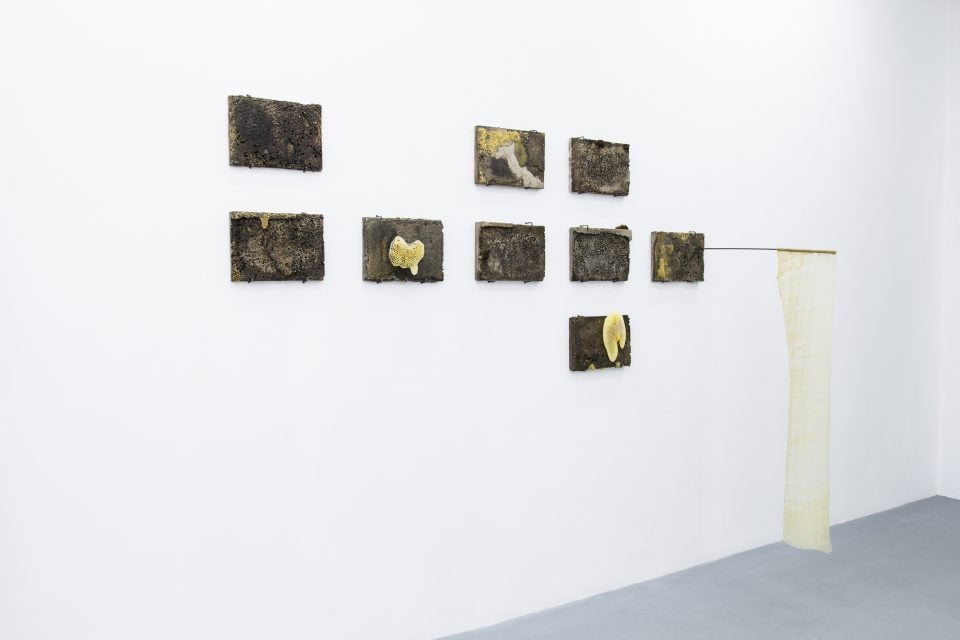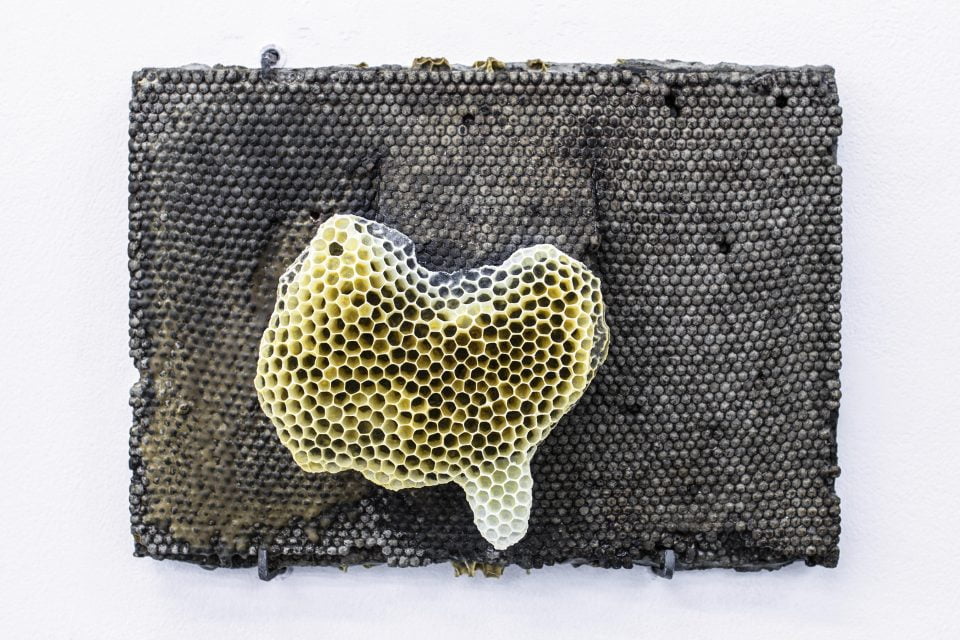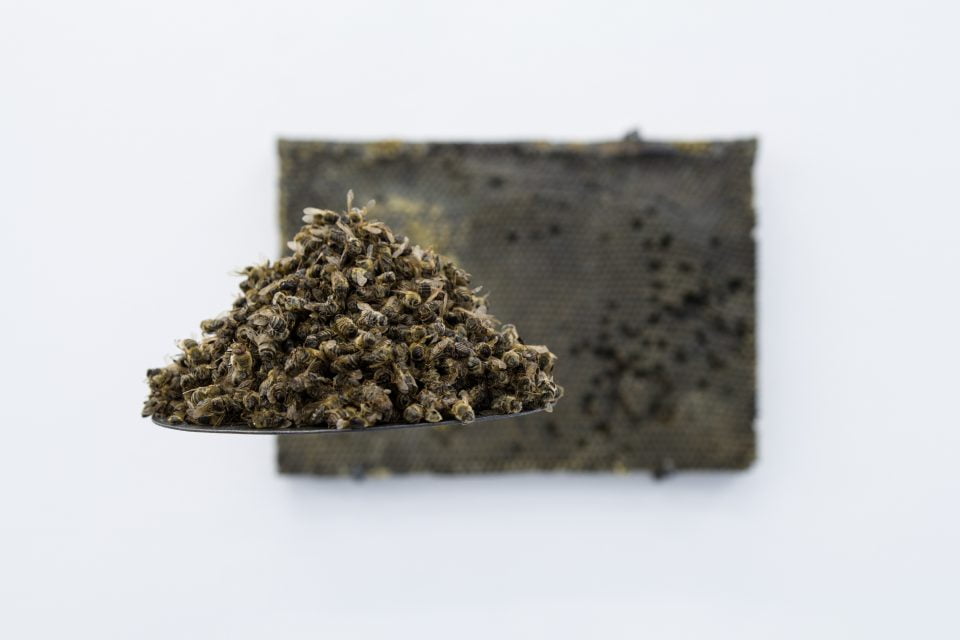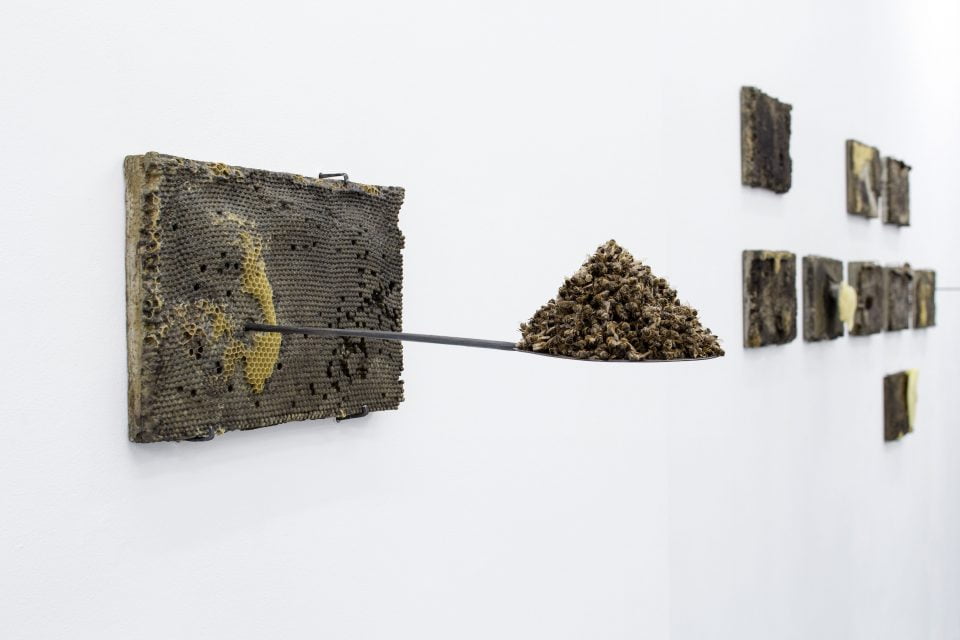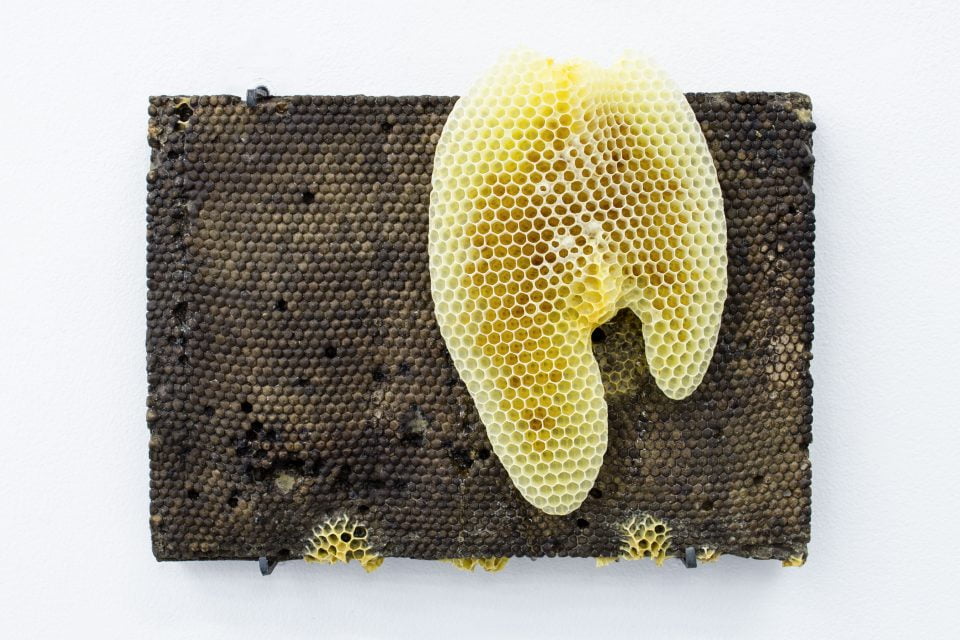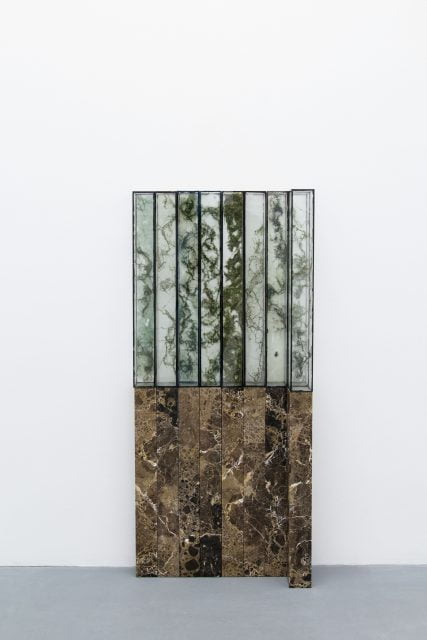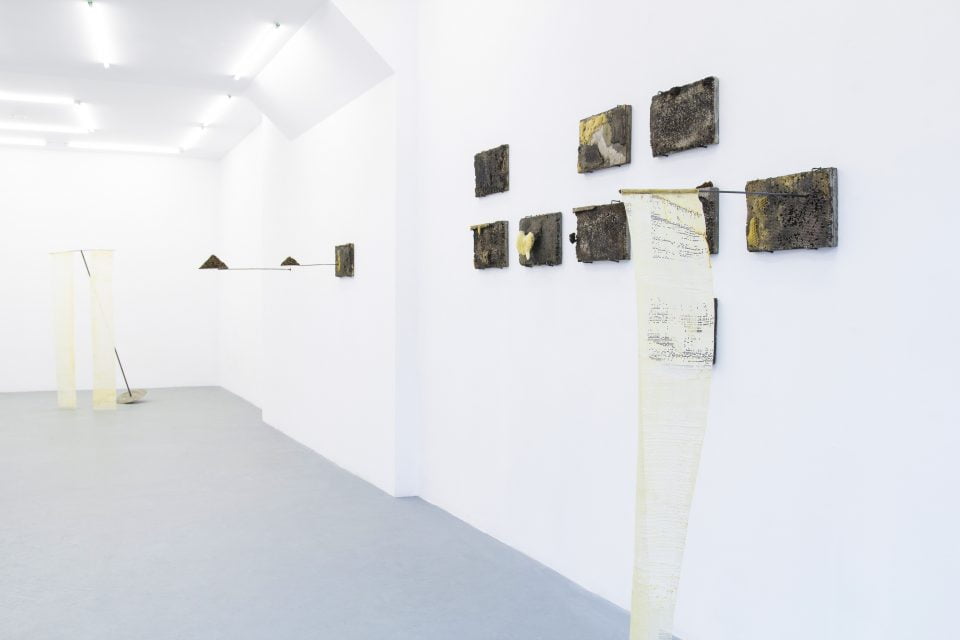By eukaryotes
Rodriguez Gallery, Poznan, 03.12.2021–05.02.2022
Piotr Bosacki, Michał Smandek
Honeycomb and Javanese moss
I said: “The more intensely I was talking about honeycomb, the more Bosacki was pushed away from the topic. And namely”, I said, “Javanese moss”. “That’s remarkable”, I said, “and I’m speaking of a trivial thing that, nonetheless, constitutes a certain phenomenon: when I was beginning to speak about honeycomb, Bosacki was starting to talk about Javanese moss. The more I was focusing on honeycomb, the more he became obsessed with Javanese moss. I talked about honeycomb, and he spoke about moss”. Bosacki said: “I was thinking this entire time: ‘you must speak of honeycombs’, but I was compelled to speak of Javanese moss”. I said: “But I was talking about honeycomb, not Javanese moss, what was I supposed to talk about on that day if not honeycomb! Naturally, I could only be thinking about honeycomb! And Bosacki was thinking only about Javanese moss! Just like I was becoming increasingly obsessed with honeycomb, Bosacki was more and more focused on Javanese moss, up to a degree when Bosacki, speaking of Javanese moss, started to annoy me, as I was speaking of honeycomb; while myself, speaking of honeycomb, started to annoy Bosacki, who was talking only about Javanese moss. “Awfully irritating!”, I said. “I could hear Bosacki interrupting my discourse about honeycomb with his comments on Javanese moss. It was remarkably puzzling”, I said, “that as time went by, I was compelled to speak more and more, only and exclusively about honeycombs and beeswax, while Bosacki couldn’t stop talking about Javanese moss. Bosacki was talking louder and louder about Javanese moss, and I was talking louder and louder about honeycomb. Loudly, with the same sound intensity, and with the same volume, both of us were talking, Bosacki about the incredible Javanese moss, and I, about the incredible honeycomb. Later, however”, I said, “there was a moment when we were both speaking only about honeycomb and then both of us were speaking about Javanese moss only. Nonetheless, as we were both speaking about Javanese moss, I was only thinking about honeycomb, and when we were talking about honeycomb, Bosacki could think only about Javanese moss. So, we alternated speaking about honeycomb, while Bosacki was thinking only about Javanese moss and Javanese mosses, and I only had honeycomb on my mind all the time. Through me, about honeycomb, through Bosacki, about moss. When we were talking about honeycomb, I was thinking that Bosacki wanted to talk about Javanese moss, and when we were talking about Javanese moss, I wanted to talk exclusively about honeycomb. “I”, said Bosacki, “wanted to talk to you about this Javanese moss and how it compares to inland moss, that I once saw in the forest, and I wanted to speak of the comparison between Javanese mosses and our domestic mosses, about the differences between our moss and Javanese moss.” I said: “Naturally, I was completely consumed by honeycomb, but Bosacki, was not in an equally natural manner obsessed with Javanese moss!”, I said. When we were talking about Javanese moss”, said Bosacki, “Smandek would shout, incessantly: High costs! or Incredible costs!, while during our conversation about honeycomb, I was constantly repeating such words as: fishkeeping, aquarium, observation, hypnaceae”. “Anyway”, I said, “on that very day, no matter what we were talking about, we were still talking only and exclusively about the exhibition”.*
Michał Smandek
By eukaryotes
Artists tend to joke a lot in a professional setting. Definitely more than lawyers. (By the way, it would be an interesting subject for statistical research in art sciences). Probably, it stems from the fact that it is often hard to define the core substance of an artistic phenomenon. Therefore, if someone works as an artist − a profession without a clearly defined substance − it’s natural that it has a lot to do with humour.
At first, we wanted to call our exhibition “Algae and Little Bees” (we joked about this), because Smandek made some objects referring to beehives, and I made objects referring to aquarium plants. Of course, we could not make a show with that title, because it sounded too childish. What is more, it could suggest that bees and plants were the main substance of our artworks, and we would not want to limit the interpretation of their meaning, which should be indefinite by default.
Nonetheless, there is no doubt that the works presented in the exhibition are the works of bees, plants and us (men). Therefore, we were looking for a common name for these three groups of craftsmen. The term Eukaryotes feels perfect. Eukaryotes (organisms with a developed nucleus) include plants and animals: bees, Javanese moss, water silk, Canadian waterweed, and homo sapiens. Thereby the title: By eukaryotes.
As a result, a typical vernissage-goer (if, for some reason, they felt the need of theoretical reflection) would associate it with ecology or even posthumanism: for example the concept that all beings are members of one big family; the concept of rejecting the anthropocentric perspective and − consequently − rejecting the idea of hierarchy between men, bees and algae.
Shortly speaking, when we chose the title By eukaryotes for our show, it was still more of a joke than a serious insight into posthumanism (if I had to choose between these two options). The joke is about us doing an exhibition together with bees and water plants. And that’s it. There is nothing more to it. And perhaps that’s for the better, because I distance myself from the concept of posthumanism.
For example, the concept (invented by humans) of rejecting the anthropocentric perspective, quite beautiful in its mythically utopian character (at least because it broadens our ecological awareness and the horizons of natural sciences), feels like philosophical greenwashing. (And, when we say “philosophical”, we are being merciful, because actually there is more nomenclature than philosophy about it). A little bit of scepticism is enough to think: A human being who declares that they “give up the human perspective” is like an orchard owner, whose “orchard management” practices have poisoned almost all the trees, after which they declare compassion towards all plants and call for an approach that would go beyond the “orchard management” perspective. And to mark a new beginning, they change the name of their discredited company from “orchard” to “postorchard”. Additionally, they start suffering from schizophrenia and start to believe that after this “terminology renewal” the next harvest in their postorchard will bring bountiful yield. (At the same time, the comment about schizophrenia is made from the point of view of an external observer who does not understand that the change affected reality, and not just terminology. Actually, we can’t even speak about a name change, because “orchard” does not exist anymore. And you cannot change the name of something that doesn’t exist).
When posthumanists come to me and start explaining the “extrahuman perspective”, I always wonder how they actually differ from Christian priests who preach about the “otherworldly kingdom of god”. (It’s a really interesting anthropological exercise from the field of Mysticism). As to “extrahuman perspectives”, I still opt for the positivist approach. Everything (every mental phenomenon) is filtered by human brain, that is: by human body. And even if thanks to some geometrical calculations we assume that the body can be stretched without limits, then every mental phenomenon (even the strangest one) will still be part of human psyche. (Old Kabbalists used to say: Humans are made of all things).
A situation when men claim that they represent some kind of “extrahuman perspective”, corresponds to the following situation: we use our printer to print a message: “This printout was not made by a printer”. Only naive people (or those who really yearn for a revelation) will believe what this message says.
Next, we have the concept of removing hierarchy between humans and other beings. The myth of everyone being equal is a beautiful utopia, but it cannot be applied in practice. In the best of cases, it can form part of crypto-mystical poetry of wishful thinking. We know from experience that the concept of an organism or system (whether physical, biological or social) devoid of hierarchy, is inherently contradictory. Let’s imagine a Solar System without hierarchy. If, somehow, we managed to remove hierarchy (like gravity) in our Solar System, we would deeply regret it after eight minutes.
Perhaps not everyone will like this text, but it’s completely honest. I apply this sincerity for the sake of art sciences. With more sincerity from artists, the anthropology of art will become more accurate.
Piotr Bosacki
*inspired by a fragment from Thomas Bernhard’s “Gargoyles”, translated by Sława Lisiecka





